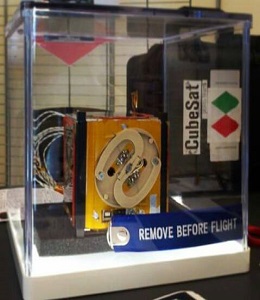e-st@r
 The Polytechnic University of Turin CubeSat | |
| Names | est@r e-star |
|---|---|
| Mission type | Technology demonstration |
| Operator | Politecnico di Torino |
| COSPAR ID | 2012-006C |
| SATCAT no. | 38079 |
| Mission duration | Final: 4 years |
| Spacecraft properties | |
| Spacecraft type | CubeSat |
| Manufacturer | Politecnico di Torino |
| Launch mass | 1 kg (2.2 lb) |
| Start of mission | |
| Launch date | 13 February 2012, 10:00:00 UTC[1] |
| Rocket | Vega (VV01) |
| Launch site | Kourou, ELV |
| Contractor | Arianespace |
| End of mission | |
| Disposal | Re-Entry |
| Deactivated | 13 February 2016 |
| Last contact | 10 February 2016 |
| Decay date | 14 February 2016 |
| Orbital parameters | |
| Reference system | Geocentric orbit[2] |
| Regime | Low Earth orbit |
| Perigee altitude | 302 km (188 mi) |
| Apogee altitude | 1,082 km (672 mi) |
| Inclination | 69.47° |
| Period | 98.47 minutes |
e-st@r (Educational Satellite @ Politecnico di Torino) was a miniaturised satellite built by the Politecnico di Torino.[3] It was a 1U CubeSat design with a 10 cm side and a mass not exceeding 1.33 kg.
Launch and deployment
[edit]In 2006 the Polytechnic University of Turin had tried to put one of its satellites into orbit (PiCPoT), but the Dnepr launcher used exploded a few seconds after the start and destroyed itself.
In 2009 the European Space Agency in view of the inaugural launch of Vega (which being the first launch had a high probability of failure) offered 9 seats on the carrier for the same number of cubesats, plus another two seats for larger satellites. Only 7 of the cubesats managed to be prepared in time for launch:
- e-st@r of the Polytechnic of Turin,
- Goliat of the Romanian Space Agency,
- MaSat-1 of the Budapest University of Technology and Economics,
- PW-Sat of the Warsaw Polytechnic,
- ROBUSTA of the University of Montpellier II,
- UniCubeSat-GG of the University of Rome La Sapienza,
- Xatcobeo of the University of Vigo.
They were launched into low Earth Orbit on the maiden flight of Arianespace's Vega rocket on 13 February 2012 on a multi-payload mission shared with LARES of the Italian Space Agency and ALMASat-1 of the University of Bologna.
The satellite was successfully deployed into orbit, and the signal was received by the team's ground station and by amateur radio operators.[4] However, operations have been impeded by unexpected tumbling, and the satellite was put into safe mode.[5]
The communication system used a PIC microcontroller and communicated with the ground at a frequency of 437.445 MHz with a power of 0.5 W. The frequencies had been assigned to cubesats by ESA.
A total of about 50,000 euros were spent on the design and construction of the satellite.
The orbit was inclined 71° and slightly elliptical. It also crossed the van Allen belts.
The satellite was created by the CubeSatTeam of the Polytechnic of Turin, responsible for creating picosatellites. The team later developed e-st@r-II to be sent to the orbit again as part of ESA's "Fly Your Satellite" program in 2016.[6]
See also
[edit]References
[edit]- ^ McDowell, Jonathan. "Launch Log". Jonathan's Space Report. Retrieved 31 October 2013.
- ^ "Display: E-STAR 2012-006C". N2YO.com. 31 October 2013. Retrieved 31 October 2013.
- ^ Sabrina Corpino, Nicole Viola, Fabrizio Stesina, and Sergio Chiesa, "Design and development of the e-st@r CubeSat", Paper IAC-09.B4.6B.3, 2009 International Astronautical Congress (accessed 16 August 2013)
- ^ E-ST@R successfully launched (accessed 16 August 2013)
- ^ eoPortal Directory, E-ST@R (Educational SaTellite @ politecnico di toRino) (accessed 16 August 2013)
- ^ Stesina, Fabrizio; Corpino, Sabrina (30 April 2020). "In Orbit Operations of an Educational Cubesat: the e-st@r-II Experience". International Review of Aerospace Engineering (IREASE). 13 (2): 40–50. doi:10.15866/irease.v13i2.18317. ISSN 2533-2279. S2CID 225938670.
External links
[edit]- http://areeweb.polito.it/cubesat-team Archived 29 September 2013 at the Wayback Machine
- http://space.skyrocket.de/doc_sdat/e-star.htm
